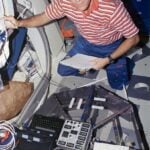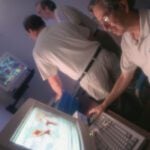Sewage Treatment With Water Hyacinths
Inducted In: 1988, Environmental and Resource Management
For more than a decade, NASA’s laboratories conducted research on the use of water hyacinths for treating and recycling wastewater for application in space colonies and long duration manned space flights of the future. Researchers discovered that water hyacinths thrive on sewage by absorbing and digesting nutrients and minerals from wastewater. Thus a means of purifying water at a fraction of the cost of a conventional sewage treatment facility had been found. Some added benefits of the hyacinths are that after routine harvesting, they can be used as fertilizer, high protein animal feed, or as a source of energy. NASA’s findings attracted considerable attention from numerous communities and municipalities interested in applying the technology.
Today, dozens of small southern towns are now using water hyacinths as their primary method for treating wastewater. San Diego built a one million gallon per day plant for service in 1984. It uses water hyacinths in a hybrid aquatic plant/microbial filter. In addition, Disney World’s EPCOT Center now operates a 50,000 to 350,000 gallon a day water treatment facility to explore advanced applications of hyacinths. The limitations of hyacinths to warm climates challenged the Stennis Space Center team to continue its research with an artificial marsh filtering system that employs a combination of sewage-digesting microbes and pollutant-absorbing plants such as bulrushes, reeds, and canna lilies.
Both cold- and salt-tolerant, the marshes can be used in northern climates to achieve the same goal as the water hyacinths. The ongoing spin-off process continues to innovate applications for use in air pollution reduction in super-insulated homes and offices through special plant and carbon filter systems.
Related Technologies

Fabric Roof Structures
Inducted In: Environmental and Resource Management
In the late 1960s, NASA's Johnson Space Center went searching for a lightweight, non-combustible fabric durable and strong enough to protect the astronauts in an alien, zero-gravity environment. One American company, Chemical Fabrics, a specialty weaver and coater, was already…

Heat Pipe Systems
Inducted In: Environmental and Resource Management
In the early days of NASA's space research, there was concern over problems of temperature control of non-rotating satellites. The side facing the sun would build up excessive heat, and the opposite side would become very cold, thus a serious…

Earth Resources Laboratory Applications Software
Inducted In: Environmental and Resource Management
In 1978, the Science and Technology Laboratory (STL), formerly the Earth Resources Laboratory (ERL), at NASA's Stennis Space Center (SSC), began its program of image and geographical information system processing of satellite and airplane data. This data-gathering process is known…
